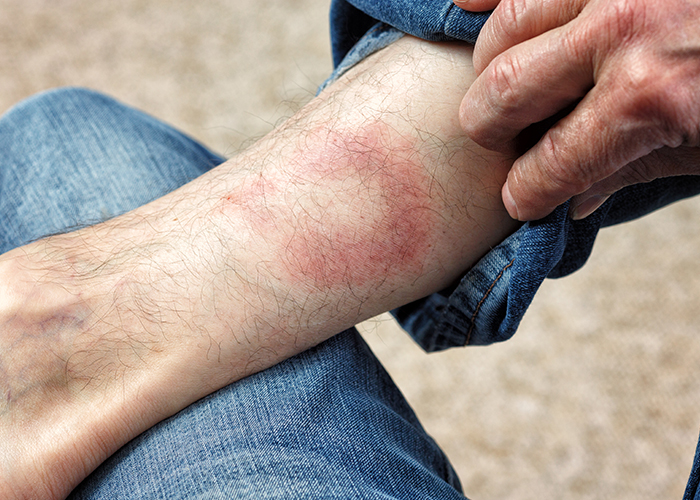Lyme Disease – a treacherous disease
with many faces and masks
Migrating Redness is a characteristic early sign of Lyme disease
Chronic fatigue, aching joints or even dizziness, and many other symptoms, can be signs that you have Lyme disease. Lyme disease (Lyme Borreliosis) is a disease caused by infection with Borrelia burgdorferi, B. afzelii, B. garinii, B. sensu strictu and B. miyamotoi bacteria. Disease course and symptoms are very different in patients.
Borrelia are spiral-shaped bacteria that were discovered in the early 1980s. At least five human pathogenic Borrelia burgdorferi species are now known in Europe. As with the TBE virus (tick-borne encephalitis virus), The tick species Ixodes ricinus (castor bean or sheep tick) in Europe also has Lyme borrelia. There are many other carriers (insects, animals).
The Borrelia are in the intestine of the tick. Once the tick finds a new host, it begins to suck blood. The borrelia then migrate into the salivary gland of the tick and are transferred into the blood of the host via saliva during the bite or sting.
Recent findings show that human-to-human transmission is possible (as in syphilis).

Lyme borreliosis –
possible signs
Not everyone develops the typical symptoms of Lyme disease following infection with borrelia through a tick bite. This is another reason why Lyme disease infection cannot always be identified as such.
The most common symptoms reported in a survey of Lyme disease patients were:
- 98% fatigue
- 97% relapses
- 93% concentration disorders
- 92% stiffness in the head and cervical spine
- 92% back pain
- 91% sore muscles
- 91% word finding disorders
- 91% burning, tingling sensations on different parts of the body
- 89% freezing or sweating
Early disease indications: erythema migrans (“migrating redness”)

Lyme disease runs in phases. The so-called early borreliosis shows up a few days after the tick bite, but can also occur up to three months later. The vast majority of those affected by Lyme disease develop the characteristic Erythema migrans. This forms a circular, usually painless, skin redness with an accentuated edge around the puncture site of the tick bite. Within days to weeks it can expand up to a diameter of more than 5 cm. The centre of the reddened area fades.
Non-specific symptoms of the early stages such as:
- headache
- fever
- fatigue and tiredness
- muscle or joint pain
may accompany the migrating redness (people think they have caught flu).
The later stages or when the Borrelia
continue to spread in the body...
Neuroborreliosis
This, in my opinion, rare manifestation of (nerve) Lyme disease can occur weeks to months after the tick bite. The symptoms are caused by meninges and nerve root inflammation and can affect individual nerves or the whole nervous system: tingling, stinging, burning, paralysis, pain and even neurological breakdowns.
An example of back pain: these originate in the nerves of the spinal cord (painful meningoradiculitis, Bannwarth syndrome, disc pain, sciatic pain). Extreme pains occur especially at night and are described as fluctuating, nagging and burning - they do not respond to usual painkillers.

Other possible symptoms and indications
in the later stages of Lyme disease are, for example:
- Head: fatigue, difficulty concentrating, headache, brain fog, dizziness, tinnitus, word finding disorders, stroke. Chronic neuroborreliosis has a diverse pattern of symptoms and includes, amongst other things, sensitivity disorders, spastic paralysis of the extremities, bladder dysfunction and cranial nerve dysfunction. Mental disorders are also possible.
- Nerves: burning, tingling, creeping and in different parts of the body.
- Blood vessels: freezing, sweating, white fingers, raised blood pressure...
- Musculoskeletal system (joints, muscles, tendons): "orthopedic" back pain, one sided knee joint pain, sciatica. Lyme arthritis is also typical. It is associated with recurrent or prolonged swelling of one or more affected large joints - usually the knee joint (often clearly swollen but not always painful). There is pain in the tendons and muscles, even spontaneous tendon and muscle tears.
- Pain in general, often on the whole of one side of the body (for me very typical for Lyme disease). Often, they do not respond to common painkillers (also very typical for me).
- Eyes: seizure-like visual disturbances
- Heart: tachycardia, cardiac arrhythmia (through pericardium and heart muscle inflammation)
- Psyche: fears, panic, depression (all sudden attacks as if from the middle of nowwhere.)
- Skin: blue-red discoloration that comes and goes, on the earlobe, nipples, scrotum, in the armpit. Acrodermatitis chronica atrophicans (ACA) is also typical: the skin on the feet and hands becomes bluish and very thin (like cigarette paper). There are blue-red, pasty swollen lesions, especially on the extensor sides of the extremities. The skin becomes thinner and the blood vessels appear under the skin.
Attention:
Lyme disease can occur in spasms!
Lyme disease often manifests itself on one side of the body!
(Especially the side where the bite was is affected!)
The later stages usually have a chronic course and occur in repeated episodes.
In the worst case, Lyme disease can lead to death if left untreated.

